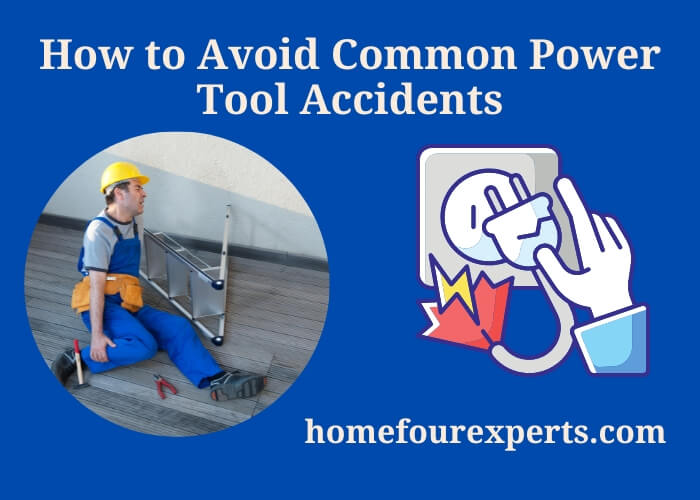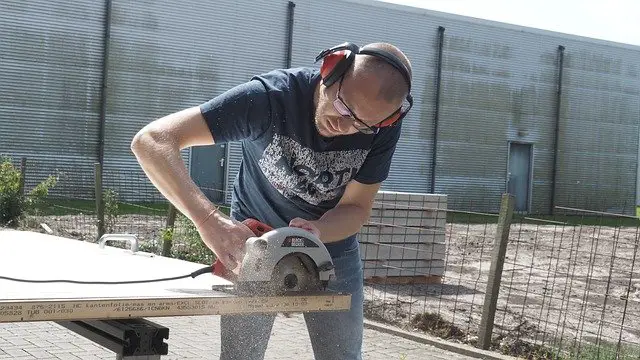Published on: January 6, 2022
Written by Eric Devin / Fact-checked by David Rowan
Every year a significant number of injuries and workplace hazards take place due to mishandling of the power tools, its malfunctions, fire from electric short circuits, explosions from gasoline, lack of protective measures against chemical substances and non-compliance of safety protocol etc.

The severe category of injuries is amputation, lacerations, electrocutions, burns, broken limbs occurred in the workshop, industries, homes, and other jobsites while dealing with the power tools. These kinds of injuries lead to permanent damage to the human organs, paralysis and sometimes even end up with deaths. However, if you take care of all the safety aspects of the power tools’ operation, it would help you prevent workplace hazards and injuries.
It’s strongly recommended to always read the User’s Instruction Manual carefully and maintain safety protocol related to the appliances, its operation, and maintenance.
I will discuss all the aspects associated with high-risk behaviors, accidents, and injuries at the workplace and give you some primary guidelines on how to avoid common power tool accidents.
Lacerations and Amputation
Abstaining from Using Saw Fence for Crosscut
Most injuries are associated with using different kinds of Saw blades. The most common category of injuries from Saws is laceration and amputation. It’s evident that most accidents happen due to lack of proper concentration while using the tools.
Another reason is that the operational safety and instructions given by the manufacturers and professionals are not adhered to strictly. There are some common mistakes that often take place while using tools. In this article, some specific operational mistakes will be discussed for better understating and critical awareness.
Number of reports from Health care facilities reveals that every year the higher number of amputations and lacerations occurred due to mishandling of four saws including nail gun, table saw, utility knives, and circular saw. One of the most harmful practices associated with the table saw is using a fence as a guide to cut the lumber to length. This devastating practice leads the lumber to get drained between the blade and the fence. Consequently, the board bounces back to the operator’s body with an accelerated force. This confounded incidence is popularly known as kick-back. Every year a significant number of cases suffer from shattered spleens, fractured spines, cracked thumbs as well as wounded eyes, etc.
Safety Advice
To avoid kick-back injuries, instead of using the fence guide, the following options are safer for cross cutting task:
- Cross-cutting sled or miter gauge could be used to have a safer cross-cut with a table saw.
- Don’t go for ripping lumbers if they are curved, bent, or wet.
- It’s important to position yourself to either side of the saw slots instead of standing directly behind the blade.
- Never allow the passersby to pass behind the operators while the saw is on operation.
- Put off all jewelry while operating tools as they could come in contact with the tool leading to severe injuries.
Don’t Seize the Blade Guard
Table saw has a built-in blade guard assembled with a splitter. The function of the guard is to prevent accidental touch while the splitter prevents the wood from getting strained on the blade leading to prevention of the kick-back. Never seize the blade guard while operating your saw to prevent lacerations. Kick-back or pushing the blade with thumbs often leads to severe injuries like broken bones, tendons or dithering ligaments etc.
Always give priority to SawStop brand while purchasing. It’s the only model which halts the blade while coming in contact to the skin.
Never operate your saw without the blade guard. If needed, replace it as immediately as possible.
Despite the blade guard, always keep your hand away from the blade as instructed by the manufacturer. Use a push stick while ripping with the blade less than 4 inches in width.
After completing ripping, unplug the saw from the power source and wait until the blade stops spinning. Stay away from the spinning blade.
Abstain from Putting Hands Directly Behind Circular Saw
Sometimes the blades of circular saw tend to bind which could cause shooting backward so fast that you barely have time to move your hand out of the blades. If your hands, fingers or legs get stuck with the blade track, it would end up with severe injuries.
Safety tips
It’s recommended to clasp your workpiece and keep your hands on the saw whenever possible to prevent injuries. Try to stand at the side of the saw instead of standing directly behind it. Follow the guideline pre, during and post operation of the tools.
Avoid Putting Hands Closer to the Nail Gun
Sometimes nails don’t go straight. There is a higher risk of nails being glanced off leading to shooting into space while driving the nail gun. Shooting into large knots can lead to bouncing the nail back and cause hand or eye injury.
Safety Tips
Have enough control over the board while holding it with your hands and keep your hands away from the nail gun snout.
Stay vigilant to protect your hand from being in the nail’s path to avoid lacerations and amputations.
Avoid holding a board near the nail gun slant. Maintain a safe distance from the nail gun to get rid of nailing through your fingers.
Wear brand eye protective glass and other protective gears specially made to prevent industrial hazards and injuries.

Stay Vigilant While Working with Utility Knives
Utility knives are pretty much likely to cause a deep cut to any part of your body due to defective handling.
Safety Tips
To prevent injuries, clasp the workpiece properly and avoid holding them with your hands. Try to keep your hands on the dull side of the knives while having a cutting task.
Eye Injuries
Another common category of injuries is related to eyes reported by the hospitals. The eye injuries occur usually at home or workshop while repairing jobs take place with the power tools. Most common type of eye injury is mainly caused by chipping wood, twigs, bits of tile, metal wrecks, paint and chemical substances etc.
It’s been reported that the particles or dust produced usually by the sanders, saws, drill machines etc. hit the eyes of the operators or the by-passers. Another potential reason for eye injury is associated with the lawnmower, leaf blower and snow blower etc. They catch the particles from the earth and injure their eyes while shooting across the lawn or snow.
Safety tips
It’s strongly recommended to wear high-impact registered safety goggles including Face shield while having a grinding task. Have spare ones in your workshop and Must-have tool box to avoid being out of stock.
Accidental Fall
The accidental fall is caused by the cords of the power tool when they lay down on the ground or the floor haphazardly leading to severe injuries including broken limbs.
Plus slippery or uneven floor or ground may cause fall. Another reason for fall injury is use of the ladder which may not be securely placed.
Safety Tips
Maintain tidiness of the workshop and avoid a messy environment. Take care of the nuisance mentioned above.
Electrocution
Electrocution is another form of injury often happens in the workshop caused by the tattered cords. It also happens while separating and replacing the parts without turning the power off.
Safety Tips
Maintain neatness of the workplace. Keep the cables away from water or liquid substances.
Always check out if there is any problem with the cords, power source or power connection. Ensure replacement or repair if necessary before further use of your devices.
Unplug all appliances from the main power source when they are not in use and store them as recommended. If any repairing of the circuit is underway, take measures to avoid electrocution and fire.
Burn Injury
Burns are often caused by the fire caught from gasoline, chemical substances, short circuits etc. Gasoline is used for different tools including lawnmowers or leaf blowers. The potential risk of gasoline is its flammability associated with explosion and fire.
Fumes from chemical substances also cause severe respiratory problems, coughing and skin irritation.
Safety Tips
Abide by the industrial safety compliance. Check out appliances, power connection, existence of chemicals and inflammable substances etc. to prevent burns and other injuries.
Final Words
I hope that you are now aware of the accidents, high risk behaviors and safety aspects associated with the power tools’ operation and maintenance.
If you strictly adhere to the safety protocol discussed above, it would remarkably minimize such injuries and deaths. Wear all Personal Protection Equipment while on operation.
It’s always suggested to have proper training on operation and maintenance on the power tools to achieve the expected outcome and reduce causes of accidental injuries. If necessary, consult the experts to have proper guidance.
As usual, I would love to hear from you about your feedback and comments. Please contact us if you need further consultation to efficiently deal with your projects. We would appreciate it if you could share this article with your family and friends. It would help us reach out to more people and offer our excellent client service.
You Might Also Like:
- Rivet Guns Analysis
- How to Unscrew a Tight Screw Without a Screwdriver
- Wet Saw VS Tile Cutter: Which is Best for Your Project
About This Writer

Hi, I am Eric Devin and I am a professional interior architect. Since childhood, I've always enjoyed DIY projects! And, I have loved to solve simple household problems using essential tools and equipment. I have also acquired a lot of information about basic household tools settings by working with contractors.